According to Steven Rothstein, president of the Perkins School for the Blind, if it takes a village to raise a child, then it takes a “big village” to raise a child with disabilities. It also takes a donor with a special kind of focus, patience, and willingness to learn.
In the Dominican Republic, a father brings his deaf and blind teenage daughter to her first day of school. Asked, “Why haven’t you brought her to school before?” he explains that for 13 years, he has been told that she was uneducable.
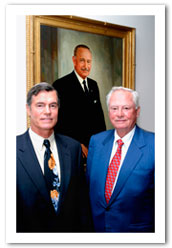 |
|
Steven M. Hilton (L), president and CEO of the Conrad N. Hilton Foundation; with Conrad's son, Barron Hilton (R), retired chairman, president, and CEO of Hilton Hotels Corporation; in front of portrait of Conrad N. Hilton
|
In Nairobi, a deaf and blind girl is abandoned by her father because he can no longer afford to care for her. She goes on to attend a Perkins partner school and learns how to knit and weave. She now supports her father and is also teaching others how to knit so that they, too, can support themselves and their families.
To say that the Perkins School for the Blind, with a sprawling 38-acre campus in Massachusetts and partner programs in 65 countries, “helps” people who are blind, deafblind, or visually impaired, including those with multiple disabilities, would be a gross understatement. The organization’s mantra is “All we see is possibility” and Perkins lives up to it by striving to empower its students—supporting them as they tap their own potential to transform their lives.
For such a nonprofit to reach its potential, it, too, needs to be empowered. And a philanthropist that shares its grantee’s values and goals, understands that it takes time to achieve long-lasting results, and is willing to learn along the way, can do that.
Fortunately, the school has just such a supporter: the Los Angeles-based Conrad N. Hilton Foundation. A significant Perkins funder for more than two decades, the Hilton Foundation has been a critical part of the school’s ability to establish, expand, and strengthen hundreds of partner organizations in the developing world.
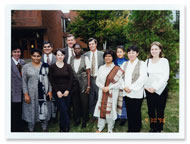 |
|
Steven M. Hilton with students in Perkins’ Educational Leadership Program
|
“When you think about people living in developing countries, you think ‘these are people who have the short end of the stick,’” Perkins President Steven Rothstein says. “People with disabilities [in these countries] have an even shorter end of the stick. A lot of foundations would say ‘This is too hard; let’s not take this on.’ Either that or they might work with you for a few years but then move on. The Hilton Foundation is different. Because of the Foundation’s enormous generosity and long-term view, we have worked with more people in this area, and started more schools for people with multiple disabilities, than anyone else.”
“Because of the Foundation’s enormous generosity and long-term view, we have ... started more schools for people with multiple disabilities than anyone else,” says Perkins President Steven Rothstein."
Conrad N. Hilton’s optimism
Conrad N. Hilton was 15 years old when he found Helen Keller’s book Optimism on his mother’s sewing table. Eight years older than he, Keller had managed to transcend her disabilities to become a student at Radcliffe and an acclaimed author. For Conrad, that chance encounter was formative. Keller’s essay, and her life story, made a deep and lasting impression on him, and when the successful hotelier launched the Conrad N. Hilton Foundation in 1944, he did so with a mission to alleviate human suffering. In his 1957 memoir, Be My Guest, Hilton recorded the impression that Keller had made on him, writing “I regarded Helen Keller and her accomplishments with an awed admiration that I have never lost.” And in his last will and testament, Conrad bequeathed to the Foundation virtually his entire estate along with a set of “cherished conclusions” that continue to guide its activities today. Tellingly, Conrad’s wording reflected Keller’s influence: People should never be “abandoned to wander alone in … darkness.” (For more on Conrad’s legacy, please see the sidebar “Conrad Hilton’s Legacy.”)
Not long after Conrad’s passing in 1979, the Hilton Foundation’s president, Donald H. Hubbs, saw an opportunity for the Foundation to take action on those words. In 1983, the Foundation made a grant to Therapeutic Living Centers for the Blind (TLC). TLC had been launched in 1975 by a group of parents who realized that no adequate therapeutic residential facilities existed anywhere for their multiply disabled, blind adult children. Working with the organization gave Hilton Foundation board members a heightened awareness of the needs of individuals who are blind with multiple disabilities, and they became determined to do more to help. In that spirit, they engaged a consultant, who recommended several funding options, including the Perkins School for the Blind.
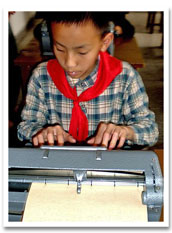 |
|
Perkins student using a brailler (braille typewriter), China
|
“We called them. They didn’t call us.”
Founded in 1829, Perkins was the first school for the blind in the United States. The school had a strong track record, a storied history—as Keller’s alma mater—and a healthy endowment of about $80 million.
The school primarily served families in the Northeast region of the United States. But sensing a much broader need, Director Kevin Lessard sought to bring its expertise to the developing world. And when Hubbs called, Lessard saw an opportunity to do just that. At the time, Conrad Hilton’s estate had yet to be fully distributed and the Foundation did not have money to give, but the exploratory call gave Lessard ample time, as well as great motivation, to develop a large-scale, comprehensive strategic plan.
Throughout most of the 1980s, the Foundation engaged in strategic planning and hiring staff in order to expand its scope and respond to Conrad’s large bequest. The board adopted a strategy to commit most of the Foundation’s giving to a small number of major, long-term projects, believing that this strategy would generate the best results. Steven M. Hilton, Conrad’s grandson (and current president and CEO), joined in 1983 as a program assistant.
Finally, in 1989 the Foundation had money to offer, and by then, Lessard was ready. He laid out Perkins’ priorities for both the United States and overseas: early intervention, teacher training, parent organizations, and curriculum development. The cost would be $15.4 million over five years. Hubbs said, “That’s fine,” before placing the request before the Hilton Foundation board that same year.
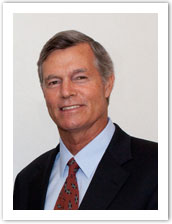 |
|
Steven M. Hilton
|
The grant was 100 times as large as the largest grant Perkins had ever received from a private foundation. And as longtime Hilton Foundation staff member Marge Brownstein, who helped prepare the original grant materials, explained, both parties approached the relationship cautiously. “Our whole board met their whole board, which is the exception, not the rule,” Brownstein said.
But the way in which the Hilton Foundation structured its support served to allay concerns on both sides—and set the stage for a productive relationship. Instead of simply funding Perkins with charitable donations, the Foundation also provided Perkins with a series of three low-interest loans, $5 million apiece, starting five years later in 1994. These loans, a form of program-related investments, or PRIs, were each contingent on Perkins raising a minimum of $2.5 million in matching funding from others. This way, the Hilton Foundation could ensure it was helping Perkins broaden its base of support even as it deepened its own commitment. (See sidebar “Why the Hilton Foundation Chose Program-Related Investments” for more detail on using PRIs.)
In addition to the loans, the Foundation made a $5 million grant in 1994 to increase the Perkins endowment and ensure the program would always exist. “It was very intentional to strengthen the endowment from the very early part of the grant,” says Steve Hilton, who, at that time, had become vice president of programs, as well as a board member.
Brownstein attests to the careful intent involved in working out the plan. “One thing Mr. Hubbs did was to make a 15-year plan—including a detailed spreadsheet—mapping out what was necessary to make [the Hilton/Perkins program] sustainable.” Including this endowment grant and its PRI loans, the Foundation’s total support stands at $65 million to date.
Holding Perkins accountable
The initial grant was—and still is—a lot of money. “It was a risky, bold move at the time,” observes Shaheen Kassim-Lakha, the Hilton Foundation’s Director of International Programs. The Foundation wanted to ensure its investment would drive results on the ground. The challenge was to do this in a way that held Perkins accountable, while empowering Perkins with the flexibility to bring its vast expertise to bear.
The Hilton Foundation started out by hiring an independent monitor. “We had our own monitor in the beginning who knew more about blindness [than we did],” says Brownstein. “But after a while, we found that his assessments of Perkins’ work weren’t really adding much value to Perkins’ self-reporting.”
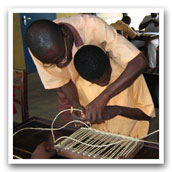 |
|
Perkins student learning to weave, Ghana
|
Subsequently, the Hilton Foundation has worked closely with Perkins to deepen Perkins’ capacity to collect and interpret data, and improve on what it was learning. For example, when Foundation staff accompanied Perkins staff on site visits in India in 2009, they noticed that results and practices varied greatly among Perkins partner organizations. This led to a discussion and eventual reframing of the evaluation methods used by Hilton/Perkins as well as the creation of new tools to monitor program quality. Says Rothstein, “The Foundation is brilliant in holding us accountable but giving us leeway to make decisions that will help us be successful and sustainable.”
“The Foundation is brilliant in holding us accountable but giving us leeway to make decisions that will help us be successful and sustainable,” says Rothstein.
240,000 children, parents and teachers … and counting
When the Hilton/Perkins program began, only nine countries had any kind of program for children who were deafblind or blind with multiple disabilities. Today, the program and its partners work in 65 countries, benefiting more than 60,000 children, families, and teachers per year. Perkins collaborates with a wide range of organizations and governments to strengthen the skills of teachers, support parents, develop university programs, advocate for improved education and disability policies, and promote Braille literacy. Over the last 20 plus years, the program has worked with approximately 240,000 children, family members, teachers, and professionals.
These are the kinds of results that excite Steve Hilton. “I doubt if there’s any group in the world that has the depth of experience as the team of the Hilton/Perkins program,” he says proudly, adding “I’m not bragging about me. I’m bragging about Perkins.”
And Rothstein is quick to share the credit. “The Hilton Foundation has given us grants, loans, and an endowment—so we’d always have an international program even if the Foundation left us today,” he says. “This affects our thinking, who we hire, and how we expand. The way they have acted has changed our culture."
Conrad Hilton’s Legacy
The Hilton/Perkins International Program remains the cornerstone of the Foundation’s work in blindness. But in addition to providing blind children with educational opportunities, the Foundation has expanded its work to prevent blindness in the first place. To date, it has given more than $40 million to reduce the spread of trachoma, an infectious disease that is a major, yet preventable, cause of blindness.
And the Foundation’s work in other areas—including (to name a few) providing safe water, helping children affected by HIV/AIDS, ending chronic homelessness, and preventing substance abuse—also continues apace. These strategic initiatives involve funding several partners, generating new knowledge, and collaborating with other funders to achieve measurable results. Steve Hilton’s legacy is still being written, of course, but as he sees it, Conrad’s desire, as expressed in his will, to “relieve the suffering, the distressed, and the destitute” is still a fundamental influence on his and the Foundation’s actions. As he explains, Conrad’s words are “not just a legal mandate, but a moral responsibility.”
That view is shared by other Hilton family members. Conrad’s son, Barron Hilton, retired chairman, president, and CEO of Hilton Hotels Corporation, pledged in 2007 and reiterated in 2010, “to follow my father’s example and donate 97 percent of my wealth to the Hilton Foundation.” He estimates that gift should bring the Foundation’s assets to more than $4 billion.
Related Reading
- Conrad N. Hilton Foundation, “The Hilton Legacy: Serving Humanity Worldwide," (2009).
Why the Hilton Foundation Chose Program-Related Investments to Support Perkins
Longtime Hilton Foundation Vice President and Chief Financial Officer Pat Modugno finds that in certain situations, PRIs are a great—and underutilized—option to benefit foundations and nonprofit recipients alike. PRIs offer foundations the opportunity to use part of their required 5 percent payout to make loans or equity investments to qualified nonprofits so long as the primary purpose of the loan is charitable (for more on payouts, click here). In Modugno’s experience, PRIs can help foundations hedge against some uncertainty. Because foundation assets can rise and fall unpredictably with markets, it can be hard for foundations to know how much money they will have to give out in any one year. Modugno thinks using PRIs when foundation coffers are larger than expected can be a good way of investing in nonprofits, without raising nonprofit expectations of large grants year in and year out. On the flip side, the returns that come from PRIs can be added back into program budgets, offering additional capital when the markets are down.
PRIs can enable recipients to make capital investments that banks are often unwilling to fund, and can allow nonprofits to raise money for these projects along the way, rather than up front. PRIs can also provide nonprofits with a buffer against uneven cash flows (like delayed government payments or other revenue streams).
The Hilton Foundation makes PRIs to existing grantees that have already undergone rigorous due diligence. Other funders who regularly make PRIs, such as the Packard Foundation, say that, for existing grantees, PRIs enable them to advance their programmatic strategies, extend their reach, and provide variety in the support they give grantees.
To determine whether PRIs might work for you, ask yourself:
- Are there nonprofits in my current portfolio that might benefit from PRIs? Often, PRIs are useful for nonprofits that need an upfront stream of cash to make a capital investment, or that perhaps receive uneven payments from other sources, so they may need help managing their cash flow.
- Under what conditions would I grant a PRI? (Consider the depth and length of your relationship with specific nonprofits).
- Do I have the in-house financial expertise to make PRIs, or do I need to consult with an external expert?
- Is my existing research of grantees sufficient to vet potential PRI recipients?
- What guarantees do I need to feel comfortable making loans? (The Hilton Foundation generally does not require collateral, relying instead on a borrowing resolution and promissory note.)
For more information, refer to the PRI Makers Network, an association of grantmakers that use program-related and other investments to accomplish their philanthropic goals.
Selected Sources
- Bridgespan interviews with Conrad N. Hilton Foundation staff: Marge Brownstein (Executive Assistant, Special Projects); Steven M. Hilton (President and CEO), Shaheen Kassim-Lakha (Director, International Programs), Patrick J. Modugno (Vice President, Administration and Chief Financial Officer), Marc Moorghen (Communications Manager).
- Bridgespan interview with Steven M. Rothstein, President of the Perkins School for the Blind.
- Conrad N. Hilton, Be My Guest (New York: Simon & Schuster, Inc., 1994), 54.
- Conrad N. Hilton Foundation, “Last will and testament,” (Accessed September 13, 2011).
- Giving Pledge, 2010 letter from Barron Hilton (Accessed June 29, 2011).
- PRI Makers Network (Accessed August 10, 2011).
- The David and Lucile Packard Foundation, “Program-Related Investments” (Accessed August 10, 2011).
- Thomas J. Tierney and Joel L. Fleishman, Give Smart: Philanthropy That Gets Results, (Public Affairs, 2011).
- Write-up by the Hilton Foundation’s Judy Miller.

